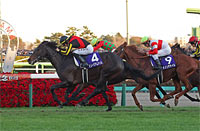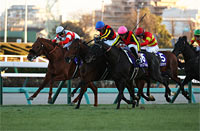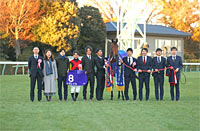Arima Kinen (The Grand Prix) (G1) - Data Analysis
Grand prix that closes out the racing year
Founded in 1956, the Arima Kinen (The Grand Prix) has gained a reputation as the curtain closer of the year. It is a high-profile event that captures the attention not only of horseracing fans but also of the general public. Let’s now look at some trends in this race based on data for the last 10 years.
Focus on runners aged 3 to 5
Three-year-olds have delivered the strongest performance in the race over the last 10 years, followed by five-year-olds and four-year-olds. Although runners aged 6 or above have also secured the victory in the past, including seven-year-old Speed Symboli in 1970 and six-year-old Green Grass in 1979, the last such runner to notch the win was six-year-old Dai Yusaku in 1991. Meanwhile, the only runner aged 6 or above to finish in the Top 3 over the last 10 years was third-place finisher Cheval Grand in 2018. In other words, we should sharply lower our expectations of horses aged 6 or above. [Table 1]
[Table 1] Performance by age (last 10 years)
| Age |
Performance
[1st-2nd-3rd-4th or lower] |
Win ratio |
Top 2 ratio |
Top 3 ratio |
| 3 |
4-3-2-16 |
16.0% |
28.0% |
36.0% |
| 4 |
2-4-2-37 |
4.4% |
13.3% |
17.8% |
| 5 |
4-3-5-45 |
7.0% |
12.3% |
21.1% |
| 6 or above |
0-0-1-32 |
0% |
0% |
3.0% |
Highly favored runners ridden by the same jockey as in the previous race have the edge
The Arima Kinen is a G1 race in which highly favored runners fare well. Over the last 10 years, runners backed as 3rd favorite or higher and ridden by the same jockey as in the previous race achieved a Top 3 ratio of over 60%. In contrast, runners backed as 4th favorite or lower and ridden by the same jockey as in the previous race had a considerably lower Top 3 ratio of 4.3%. In addition, for those looking for a dark horse, we note that runners backed as 4th favorite or lower and ridden by a different jockey from the previous race have produced nine Top 3 finishers, so runners with such a profile seem to have some appeal. [Table 2]
[Table 2] Performance by favoritism and jockey status (last 10 years)
| Favoritism, jockey |
Performance
[1st-2nd-3rd-4th or lower] |
Win ratio |
Top 2 ratio |
Top 3 ratio |
3rd favorite or higher, same
jockey as in previous race |
7-3-3-8 |
33.3% |
47.6% |
61.9% |
4th favorite or lower, same
jockey as in previous race |
1-1-1-67 |
1.4% |
2.9% |
4.3% |
3rd favorite or higher,
different jockey |
1-0-4-4 |
11.1% |
11.1% |
55.6% |
4th favorite or lower,
different jockey |
1-6-2-51 |
1.7% |
11.7% |
15.0% |
Runners coming from the Kikuka Sho, Tenno Sho (Autumn), Japan Cup, or an overseas G1 race enjoy success
The Top 3 finishers in the Arima Kinen over the last 10 years came from one of the eight races shown in the table below. Among these runners, those coming from the Kikuka Sho (Japanese St. Leger), Tenno Sho (Autumn), Japan Cup, or an overseas G1 race (Prix de l’Arc de Triomphe, Cox Plate) delivered many Top 3 finishers. [Table 3]
[Table 3] Performance by previous race (last 10 years)
| Previous race |
Performance
[1st-2nd-3rd-4th or lower] |
Win ratio |
Top 2 ratio |
Top 3 ratio |
| Tenno Sho (Autumn) |
3-2-1-12 |
16.7% |
27.8% |
33.3% |
| Japan Cup |
2-2-4-44 |
3.8% |
7.7% |
15.4% |
| Kikuka Sho (Japanese St. Leger) |
2-2-2-7 |
15.4% |
30.8% |
46.2% |
| Prix de l’Arc de Triomphe |
1-1-2-5 |
11.1% |
22.2% |
44.4% |
| Copa Republica Argentina |
1-0-0-6 |
14.3% |
14.3% |
14.3% |
| Cox Plate |
1-0-0-0 |
100% |
100% |
100% |
| Queen Elizabeth II Cup |
0-2-1-21 |
0% |
8.3% |
12.5% |
| Kinko Sho |
0-1-0-12 |
0% |
7.7% |
7.7% |
| Other race |
0-0-0-23 |
0% |
0% |
0% |
Target runners with a Top 4 finish in previous race
In the previous paragraph, we highlighted the many strong performances by runners coming from the Kikuka Sho, Tenno Sho (Autumn), Japan Cup, or an overseas G1 race, and we note that runners that had finished in the Top 4 of those races achieved considerably high success ratios. We therefore should focus on runners with such a record. [Table 4]
[Table 4] Performance by runners coming from Top 4 finish in major race (last 10 years)
| Previous race |
Performance
[1st-2nd-3rd-4th or lower] |
Win ratio |
Top 2 ratio |
Top 3 ratio |
| Tenno Sho (Autumn) |
3-1-1-2 |
42.9% |
57.1% |
71.4% |
| Japan Cup |
2-1-3-12 |
11.1% |
16.7% |
33.3% |
| Kikuka Sho (Japanese St. Leger) |
2-1-2-5 |
20.0% |
30.0% |
50.0% |
| Overseas G1 race |
2-0-0-0 |
100% |
100% |
100% |
Seek out the winner!
Runners that have delivered electrifying performances in Triple Crown races as a three-year-old and winners of a same-year G1 race have the edge
Winners of the Arima Kinen in recent years have often performed well in previous Triple Crown races as a three-year-old. Nine of the last 10 winners had finished in the Top 3 of a Triple Crown race, and eight had finished in the Top 2 of such a race. In addition, seven of the 10 winners had won a G1 race in the same year. In other words, we should regard runners that have delivered a strong performance either as a three-year-old or in a same-year G1 race as leading contenders. [Table 5].
[Table 5] Winners’ performance in Triple Crown races as a three-year-old, and experience of winning a same-year G1 race (last 10 years)
| Year |
Winner |
Performance in Triple Crown races as a three-year-old |
Experience of
winning a
same-year G1 race |
| 2013 |
Orfevre |
Satsuki Sho
(Japanese 2000 Guineas),
1st |
Tokyo Yushun
(Japanese Derby),
1st |
Kikuka Sho
(Japanese St. Leger),
1st |
None |
| 2014 |
Gentildonna |
Oka Sho
(Japanese 1000 Guineas),
1st |
Yushun Himba
(Japanese Oaks),
1st |
Shuka Sho,
1st |
Dubai Sheema Classic |
| 2015 |
Gold Actor |
‐ |
‐ |
Kikuka Sho
(Japanese St. Leger),
3rd |
None |
| 2016 |
Satono Diamond |
Satsuki Sho
(Japanese 2000 Guineas),
3rd |
Tokyo Yushun
(Japanese Derby),
2nd |
Kikuka Sho
(Japanese St. Leger),
1st |
Kikuka Sho
(Japanese St. Leger) |
| 2017 |
Kitasan Black |
Satsuki Sho
(Japanese 2000 Guineas),
3rd |
Tokyo Yushun
(Japanese Derby),
14th |
Kikuka Sho
(Japanese St. Leger),
1st |
Tenno Sho (Autumn),
etc. |
| 2018 |
Blast Onepiece |
‐ |
Tokyo Yushun
(Japanese Derby),
5th |
Kikuka Sho
(Japanese St. Leger),
4th |
None |
| 2019 |
Lys Gracieux |
Oka Sho
(Japanese 1000 Guineas),
2nd |
Yushun Himba
(Japanese Oaks),
5th |
Shuka Sho,
2nd |
Takarazuka Kinen,
etc. |
| 2020 |
Chrono Genesis |
Oka Sho
(Japanese 1000 Guineas),
3rd |
Yushun Himba
(Japanese Oaks),
3rd |
Shuka Sho,
1st |
Takarazuka Kinen |
| 2021 |
Efforia |
Satsuki Sho
(Japanese 2000 Guineas),
1st |
Tokyo Yushun
(Japanese Derby),
2nd |
‐ |
Tenno Sho (Autumn),
etc. |
| 2022 |
Equinox |
Satsuki Sho
(Japanese 2000 Guineas),
2nd |
Tokyo Yushun
(Japanese Derby),
2nd |
‐ |
Tenno Sho (Autumn) |
(Yodohito Himezono)
|

- Preview
- Barrier draw
- Past performances of runners

- News
- Race result
- Video
- 2025 English

- 2024 English

- 2023 English

- 2022 English

- 2021 English

- 2020 English

- 2019 English

- 2018 English

- 2017 English

- 2016 English

- 2015 English

- 2014 English

- 2013 English

- 2012 English

- Photo Gallery
2025 Winner: Museum Mile

2024 Winner: Regaleira


|



















